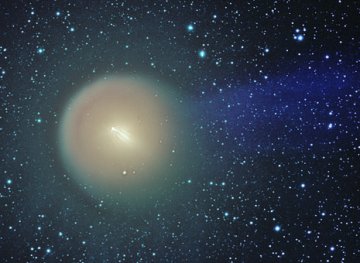komt hier een [Centraal] Astronomie Topic.....
Plaats hier de astronomische gebeurtenis(sen)
die binnenkort gaan gebeuren.
Plaats hier liefst eigen gemaakte foto's.
Hoe goed of slecht ze ook zijn ("nobody is perfect")
Op zoek naar een vereniging bij jou in de buurt !?!
Koninklijke Nederlandse Vereniging voor Weer- en Sterrenkunde
LINKS:
De 9 planeten
Maanfases deze maand
Spaceweather.com
Interactive sky chart
Sterrenkunde & Ruimtevaart
Astro fotografie met webcam & digitale camera
Remote Controled Telescope ( 7 DAYS FREE TRAIL )
Zoek je een proggie...
Altijd willen zien hoe melkwegstelsels op elkaar botsen
dan zijn er 2 mooie proggies
Colliding Galaxies (dank aan Quarks voor de link)
Gravity3D 1.5 (441 KB)
Celestia Home Page
Wil je zelf in een ruimteschip rondvliegen en de planeten bezoeken? Of wil je liever een kijkje nemen bij andere sterren, zelfs bij exoplaneten? Het is allemaal mogelijk met Celestia. Een prachtig programma met een realistische weergave van objecten.
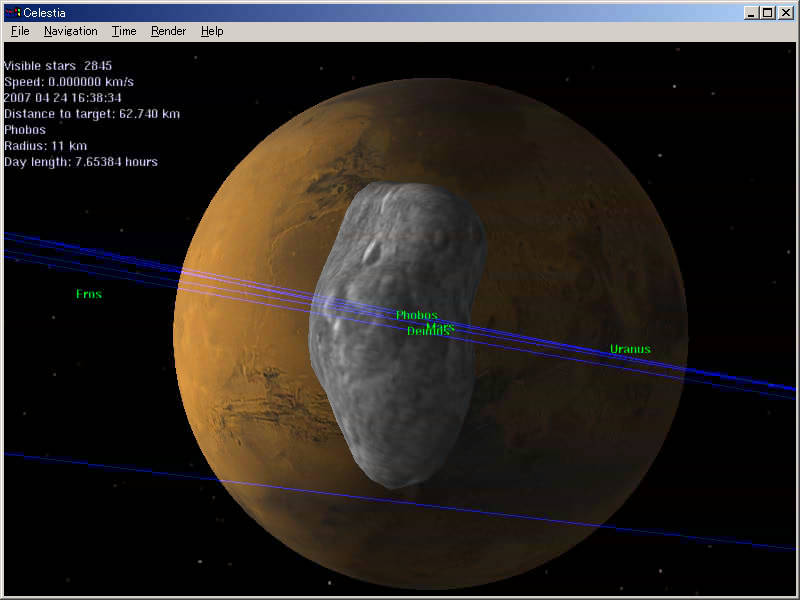
Starcalc Home Page
Ga je vanavond zelf in je eigen tuin waarnemen? Print dan een mooie sterrenkaart waarop alle sterren staan die er die avond te zien zullen zijn. De sterrenkaart bevat alle 110 messier objecten en vele sterren (ook degene die niet met het oog zichtbaar zijn).
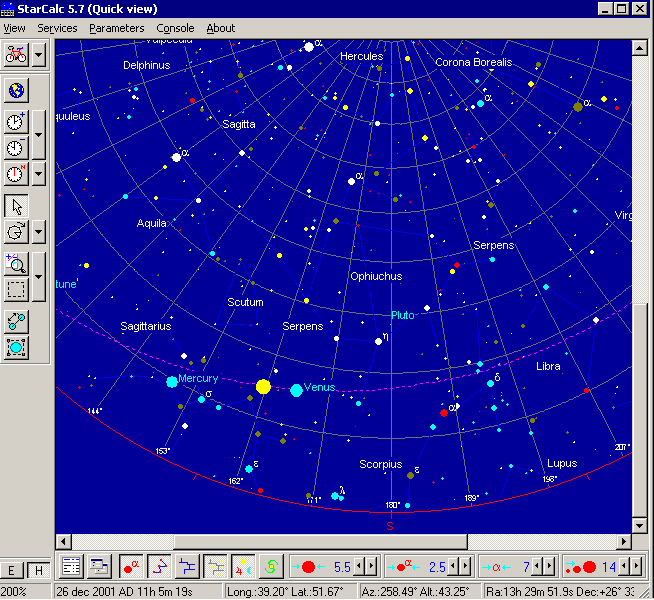
Winorbit Home Page
Wanneer komt een bepaalde satelliet over de aarde? Dat kun je voorspellen met dit mooie programma. Je kunt zelfs je eigen woonplaats opgeven en dan voorspelt het programma wanneer er een heldere satelliet zal opflitsen. Handig en snel.

[ Bericht 6% gewijzigd door -CRASH- op 20-10-2004 00:06:37 ]
Maansverduistering
In de vroege ochtend van donderdag 28 oktober 2004
is in het Westen een volledige maansverduistering te zien.
De verduistering begint rond 02.09 uur en duurt tot ongeveer 08.00 uur.
De intrede van de Maan in de kernschaduw van de Aarde begint rond 03.15 uur
op 44 graden boven de horizon in het Zuid-Westen.
De totaliteit wordt rond 02:24 uur bereikt.
De uittrede uit de kernschaduw begint ongeveer om 05.43 uur.
De kernschaduw is rond 06.52 uur verlaten op 15 graden
boven de horizon in het Westen.
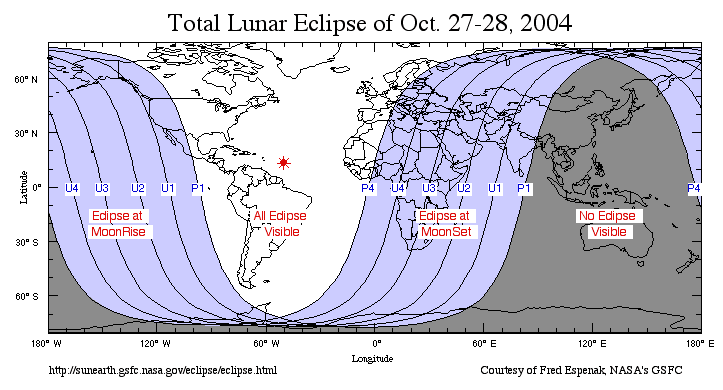
[ Bericht 33% gewijzigd door -CRASH- op 19-10-2004 00:34:48 ]
quote:Bij de links staat een interaktieve sterrenkaart.Op dinsdag 19 oktober 2004 00:28 schreef krakkemieke het volgende:
Kweenie of het off-topic is.... Maar bij Linux kreeg ik een sterrenkaart programma.
Is er hier iemand die Astromist 1.7 gebruikt (met of zonder telescoop)?
[ Bericht 8% gewijzigd door -CRASH- op 19-10-2004 02:32:58 ]
En van mijn kant een schaamteloze t.v.p.
quote:Dito hieroOp dinsdag 19 oktober 2004 11:06 schreef pfaf het volgende:
Mooie OP -CRASH-
En van mijn kant een schaamteloze t.v.p.
Ik heb nu niet zo gek veel tijd maar zal zeker er tijd voor uittrekken om de links eens uittepluizen.
Colliding Galaxies
Wat is het
Een sterrenstelsel simulator
Maar wat kun je er allemaal mee
Features:
→ Up to one million particles (stars)
→ Editing of the Galaxies in Graphic-mode
→ Editor to create real galaxies
→ Creating of AVI-films and TGA-pics
→ Free camera position (rotation, zoom)
→ Stereo mode for real 3d-effects
→ Doppler effect (redshift)
→ Different sizes of particles
→ Window or Fullscreen mode
Hoe ziet het eruit


Leuk, waar kan ik het downloaden
Hierzo
quote:Op dinsdag 19 oktober 2004 17:36 schreef Quarks het volgende:
Nog een leuk programma:
Colliding Galaxies
Dan ken ik er ook nog 1
When galaxies collide.....
[ Bericht 42% gewijzigd door -CRASH- op 19-10-2004 23:41:25 ]

The current cycle - larger image
quote:bronSolar Cycle Update
by Dr Tony Phillip
for NASA Science News
Huntsville AL (SPX) Oct 19, 2004
Solar physicist David Hathaway has been checking the sun every day since 1998, and every day for six years there have been sunspots. Sunspots are planet-sized "islands" on the surface of the sun. They are dark, cool, powerfully magnetized, and fleeting: a typical sunspot lasts only a few days or weeks before it breaks up. As soon as one disappears, however, another emerges to take its place.
Even during the lowest ebb of solar activity, you can usually find one or two spots on the sun. But when Hathaway looked on Jan. 28, 2004, there were none. The sun was utterly blank.
It happened again last week, twice, on Oct. 11th and 12th. There were no sunspots.
"This is a sign," says Hathaway, "that the solar minimum is coming, and it's coming sooner than we expected."
Solar minimum and solar maximum - "Solar Min" and "Solar Max" for short -are two extremes of the sun's 11-year activity cycle. At maximum, the sun is peppered with spots, solar flares erupt, and the sun hurls billion-ton clouds of electrified gas toward Earth.
[...]
"Contrary to popular belief," says Hathaway, "the solar cycle is not precisely 11 years long." Its length, measured from minimum to minimum, varies: "The shortest cycles are 9 years, and the longest ones are about 14 years."
[...]
"We examined data from the last 8 solar cycles and discovered that Solar Min follows the first spotless day after Solar Max by 34 months," explains Hathaway.
The most recent solar maximum was in late 2000. The first spotless day after that was Jan 28, 2004. So, using Hathaway and Wilson's simple rule, solar minimum should arrive in late 2006. That's about a year earlier than previously thought.
The next solar maximum might come early, too, says Hathaway. "Solar activity intensifies rapidly after solar minimum. In recent cycles, Solar Max has followed Solar Min by just 4 years." Do the math: 2006 + 4 years = 2010.
hmmm interessant, Zonne min en max komen "iets" eerder "dit jaar"
quote:Op woensdag 20 oktober 2004 12:40 schreef Quarks het volgende:
Hier een overzicht van veel astronomie software.
Helaas kan ik het niet meer toevoegen aan de openings post.
Gelijk ff Dance of the planets gedownd
*slecht verkapte tvp*
http://home.planet.nl/~romme102
http://www.starrynight.com/
quote:Op donderdag 21 oktober 2004 14:56 schreef whosvegas het volgende:
In het bovenstaande overzichtje van astronomische software, is nog een programma vergeten: Stars. Stars is een nederlands planetarium programma (met de sterrenbeelden in de gewone nederlandse benamingen). Homepage van Stars:
http://home.planet.nl/~romme102
quote:Ze zitten dacht ik op versie 4.5. Of is versie 5 al uit?Op zaterdag 23 oktober 2004 13:52 schreef gigatech het volgende:
De top is toch echt Starrynight 5 op dit moment is een perfect programma voor de amateur astronoom met een database die "volledig is"
quote:De pro plus versieOp zaterdag 23 oktober 2004 13:52 schreef gigatech het volgende:
De top is toch echt Starrynight 5 op dit moment is een perfect programma voor de amateur astronoom met een database die "volledig is"
Daar is de prijs dan ook wel naar.
Voor de serieuze amateur is het wel fantastisch.
www.skymap.com
Je kunt er een demo versie downkoaden. Dit programma heb ik gebruikt om Stars te testen
Of TheSky (lijkt me een mooi programma):
http://www.bisque.com/v6/TheSky_Version_6.htm
quote:Starry Night is in hoofdzaak bedoelt om simulaties te maken. Als ik een planetarium programma uit zou moeten zoeken dat ik bij serieuze amateur waarnemingen zou gebruiken zou ik niet Starry night kiezen.Op zaterdag 23 oktober 2004 14:03 schreef Quarks het volgende:
[..]
De pro plus versie
Daar is de prijs dan ook wel naar.
Voor de serieuze amateur is het wel fantastisch.
Starry night is mooi voor op een volkssterrenwacht om het publiek kennis te laten maken met de sterrenhemel.
quote:Je heb gelijk versie 5 is uitOp zaterdag 23 oktober 2004 13:52 schreef gigatech het volgende:
De top is toch echt Starrynight 5 op dit moment is een perfect programma voor de amateur astronoom met een database die "volledig is"
Tuesday, October 26, 2004 Posted: 3:14 PM EDT (1914 GMT)
Newly discovered galactic highways cut across the Milky Way
at odd angles, bringing stars through the neighborhood of our solar system.
The roads of rebels could be part of a galaxywide system of
divergent stellar byways, researchers say.
The sun and most other stars in our Milky Way orbit the
galactic center on fairly routine, circular paths.
So astronomers were surprised to find in a new survey that
about 20 percent of the stars within 1,000 light-years of the sun
are moving on a bunch of offbeat trajectories.
The sun is at "a crossroads of many streams," according to a
research team that examined data on more than 100,000 stars
gathered by the European Space Agency's Hipparcos satellite.
The routes are mostly headed toward or away from the galactic center,
like spokes on a wheel. Stars on each of the courses vary significantly
in age and composition, suggesting they had different origins and haven't
always been on their present paths.
"They resemble casual travel companions more than family members,"
said Benoit Famaey, Université Libre de Bruxelles, Belgium.
So what caused all the commotion?
Density waves
Famaey's team says the stars have been gravitationally
stirred by the spiral arms of the Milky Way. Each arm is
packed with more stars and gas than the areas between the arms.
These density waves, as astronomers call them,
compress gas and force star formation.
They can also deflect the motion of stars.
"If these stars are kicked by a spiral arm, they can be displaced
thousands of light-years away from their birthplace," Famaey said.
While the setup might sound chaotic, there is little if any additional
threat to our solar system. In principle, the newly realized star-paths
mean the chance of a collision or other interaction with the sun is greater
than was previously known, said Alain Jorissen, also of Université Libre.
"But in practice," Jorissen told SPACE.com, "average distances between
stars are so large anyway that the chance of a close encounter remains quite small."
Eventually, most of the rebels will be straightened out.
Over time, the disruptive effect of a spiral arm will vanish as a star moves
away from the arm and the galaxy's collective gravity takes over.
"It is likely that the star will then find itself on a more conventional orbit," Jorissen said.
The next close call
The closest know stars are a trio that make up the Alpha Centauri system,
which is 4.36 light-years away.
A light-year is the distance light travels in a year, about 6 trillion miles (10 trillion kilometers).
Meanwhile, our next known close encounter with another
star will occur 1.4 million years from now.
A star named Gliese 710, found by Hipparcos and reported in 1999,
will pass within 1 light-year of the sun.
That puts it some 70,000 times the distance from Earth to the sun,
on the very fringes of our solar system where icy objects are thought to
roam in what's known as the Oort Cloud. Such stellar close calls in the past
are thought to have rerouted comets from the Oort Cloud toward the inner solar system,
where some hit Earth.
Gliese 710 "does not seem to belong to one of our streams," Jorissen said.
To turn the Hipparcos data into a 3-D view of the solar neighborhood,
the researchers added observations on each star's movement collected
by a Swiss telescope at the Observatoire de Haute-Provence in France.
The results are detailed this month in the European journal Astronomy & Astrophysics.
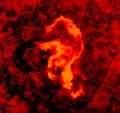
Last week an X7-class solar flare
from giant sunspot 720 sparked the
most intense radiation storm in 15 years.
"An astronaut caught outside [his spaceship]
when the storm hit would've gotten sick,"
says NASA's chief radiation health officer.
"But the dose would not have been fatal."
picture of the day!
De mooiste high-res plaatjes. Of post ik hier iets over-bekends?
Wie gaat er ook naar de totale zonsverduistering in maart 2006? In Nederland zal hij slechts gedeeltelijk zijn, maar in Turkije is hij volledig. Ik ga erheen
The Japanese Space Agency's Hayabusa probe is trying again today
(26-11) to land on asteroid Itokawa.
Its mission: to collect samples of the asteroid for return to Earth in 2007.
Stay tuned for updates.
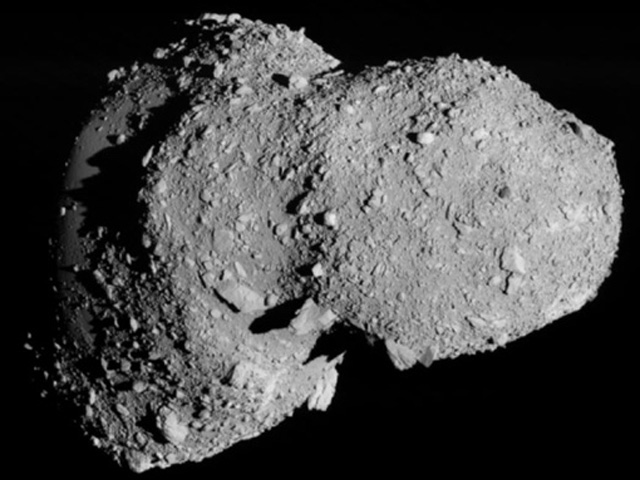
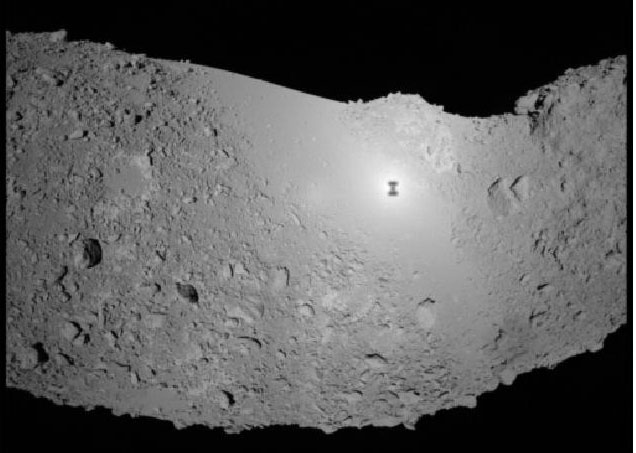
Above: The shadow of space-probe Hayabusa on asteroid Itokawa.
What makes the ground around the shadow glow?
That's the opposition effect.
At the sub-solar point, the shadows of, e.g., rocks and pebbles and
grains of dust are hidden directly beneath the rocks and pebbles and dust.
The absence of shadows causes the brightening.
quote:Zal de laatste poging zijn ofnie? Meende me te herinneren dat het lanceervenster sloot in november?Op zaterdag 26 november 2005 00:57 schreef -CRASH- het volgende:
GOOD LUCK, JAPAN:
The Japanese Space Agency's Hayabusa probe is trying again today
(26-11) to land on asteroid Itokawa.
Its mission: to collect samples of the asteroid for return to Earth in 2007.
Stay tuned for updates.
[afbeelding]
[afbeelding]
Above: The shadow of space-probe Hayabusa on asteroid Itokawa.
What makes the ground around the shadow glow?
That's the opposition effect.
At the sub-solar point, the shadows of, e.g., rocks and pebbles and
grains of dust are hidden directly beneath the rocks and pebbles and dust.
The absence of shadows causes the brightening.
http://www.dekoepel.nl/
Ik bedoel dus de sterrengids 2006
Nog een interessant WFL topic! Good work CRASH
quote:Op zaterdag 26 november 2005 15:04 schreef star_gazer het volgende:
Het is gelukt met die Japanse sonde
quote:Ik zag deze te laat, heb nu een deel van deze op in mijn topic gezet.Op maandag 12 december 2005 20:02 schreef Boswachtertje het volgende:
Prachtig topic Crash! Duidelijk een tvp! Ideaal, alleen nu nog combineren met Het Astronomie Topic van Quarks
Misschien is het inderdaad handig om deze samen te voegen.
quote:Heel mooi (GROOT) plaatje!All (known) bodies in our Solar System larger than 320 kilometer in diameter
http://kokogiak.com/solarsystembodies_metric.jpg
een maansverduistering.
Helaas is het vanuit Europa NIET te zien
Starynight online BETA
Astronomers around the world agree, Comet 17P/Holmes is one of
the strangest things ever to explode in the night sky. It's a comet,
yet it looks like a planet with a golden core and a green atmosphere
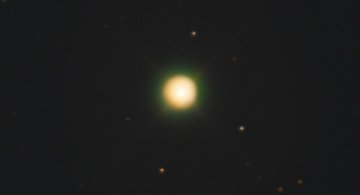
Chris Shur of Payson, Arizona, took this picture last night using his
12.5-inch telescope and a Canon XTi digital camera.
"The comet was yellow and green, very bright in the viewfinder," he says
Yesterday, Comet Holmes shocked sky watchers with a spectacular eruption,
brightening almost a million-fold from 17th to 2.5th magnitude in a matter of hours.
The comet is now visible to the naked eye--even from light polluted cities--high in the
northern sky after sunset: finder chart.
The golden hue of Holmes' core is probably the color of sunlight scattered by comet dust,
while the green fringe likely signifies an atmosphere rich in diatomic carbon and cyanogen
(substances found in many green comets). There are reports that the fuzzball is expanding
and taking on a lopsided shape--the first signs of a tail? Amateur astronomers are encouraged
to monitor developments. After sunset, point your backyard telescope at the extra "star
" in the thigh of Perseus.
quote:AAAAAAAAAAAAARGH! Het is bewolkt! Ik wil mijn 20cm dobson hier wel eens op richten!Op donderdag 25 oktober 2007 22:34 schreef -CRASH- het volgende:
Strange Comet:
Astronomers around the world agree, Comet 17P/Holmes is one of
the strangest things ever to explode in the night sky. It's a comet,
yet it looks like a planet with a golden core and a green atmosphere
[ link | afbeelding ]
Chris Shur of Payson, Arizona, took this picture last night using his
12.5-inch telescope and a Canon XTi digital camera.
"The comet was yellow and green, very bright in the viewfinder," he says
Yesterday, Comet Holmes shocked sky watchers with a spectacular eruption,
brightening almost a million-fold from 17th to 2.5th magnitude in a matter of hours.
The comet is now visible to the naked eye--even from light polluted cities--high in the
northern sky after sunset: finder chart.
The golden hue of Holmes' core is probably the color of sunlight scattered by comet dust,
while the green fringe likely signifies an atmosphere rich in diatomic carbon and cyanogen
(substances found in many green comets). There are reports that the fuzzball is expanding
and taking on a lopsided shape--the first signs of a tail? Amateur astronomers are encouraged
to monitor developments. After sunset, point your backyard telescope at the extra "star
" in the thigh of Perseus.
quote:Nu is je kansOp donderdag 25 oktober 2007 22:57 schreef star_gazer het volgende:
[..]
AAAAAAAAAAAAARGH! Het is bewolkt! Ik wil mijn 20cm dobson hier wel eens op richten!
quote:Klik

[ Bericht 3% gewijzigd door -CRASH- op 30-10-2007 21:44:24 ]
Nou nog wat betere weers omstandigheden
quote:Comet 17P/Holmes Photo GalleryCOMET 17P/HOLMES:
Sometimes a picture is worth a thousand words:
This is a composite image of exploding Comet 17P/Holmes. French astrophotographer Sebastian Voltmer combined various exposures taken through his 4.1-inch refracting telescope to highlight the comet's bright golden core (with jets and streamers), its gossamer green halo and an emerging faint blue tail. It's one of the strangest and most beautiful photos of a comet ... ever.
If that doesn't make you want to see Comet Holmes with your own eyes, perhaps this will: "The comet is growing fantastically," reports Thorsten Boeckel of Fuerstenfeldbruck, Bavaria, who has been monitoring the expansion: image. "By Sunday," he estimates, "it will be half as wide as a full Moon."
Comet Holmes is easy to find. After sunset, look north for an expanding fuzzball in the constellation Perseus: sky map. Point your telescope and--voila!--an exploding comet.
Sky Map
FF tussen de wolken door (21:36) 3 foto's gemaakt.
heb een uitsnede van de foto van 03-11 in de gecropte foto van 30-10 geplaatst

[ Bericht 5% gewijzigd door -CRASH- op 03-11-2007 22:56:36 ]

De heldere ster (rechts) is Mirfak.
Canon 350D, ISO 1600, F5.6....
En de foto wat donkerder gemaakt
